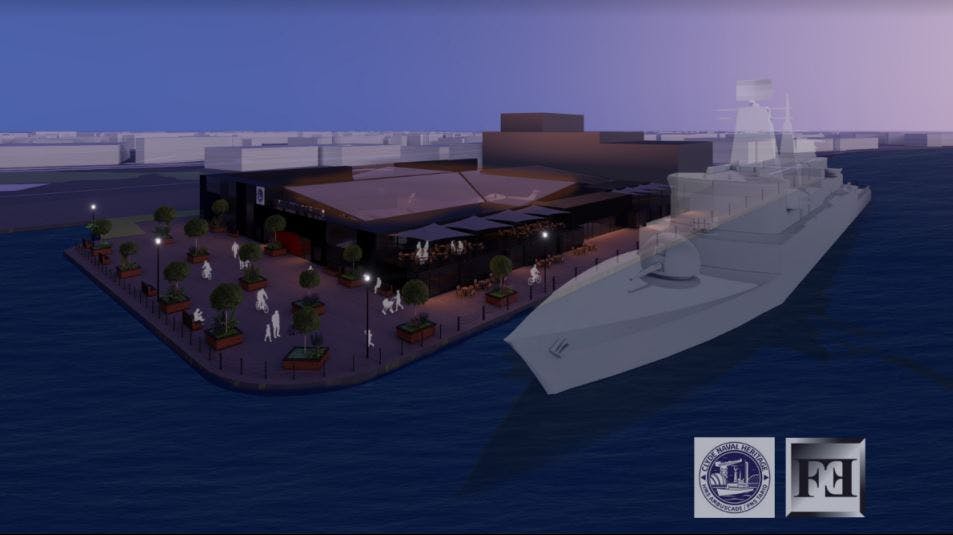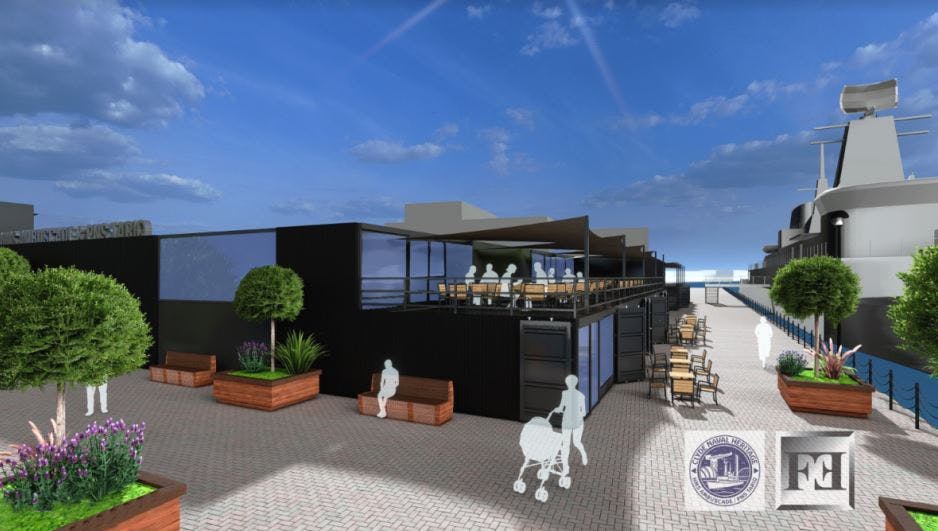Scotland is set to anchor a groundbreaking attraction on the River Clyde, promising to offer insight into the Falklands War and Glasgow’s storied shipbuilding heritage.
The ambitious project revolves around HMS Ambuscade, a frigate with a distinguished service record, which would voyage back to its birthplace from Pakistan for a new lease on life as a museum ship.
This initiative is led by David O’Neill, a visionary who has successfully negotiated with the Pakistan Navy to bring the vessel from its current location in Pakistan back to Glasgow, where it was originally launched from Yarrows shipyard in 1973.
David told me what he aims to achieve and what he is planning.
“For the first time in the UK we hope to create a new Falklands heritage site that respects the contribution that the Clyde has made to the history of the Royal Navy and commercial shipping globally. For the first time you will be able to go aboard a RN Warship 365 days a year, walk amongst exhibits from the Falklands Conflict and learn about life as a shipyard worker. The veterans stories will be told of how they served in these great ships.
The next stage is the launch of our National Appeal, to raise £2.1m to bring her home, this will include options for the public to put their name virtually on the ship and for commercial partners to show their brand support for Royal Navy heritage. There will be a series of events from Karachi via Suez, Gibraltar and finally a flotilla welcome on the Clyde, all with global media focus on this historic moment.”

HMS Ambuscade, a Type 21 Frigate, played a significant role in the Falklands War before being sold to Pakistan in 1993. Its return is part of a wider vision to celebrate and educate the public about the Falklands conflict and the rich history of shipbuilding on the Clyde. The location for this floating museum is still under consideration, with potential sites at Greenock or Govan docks being discussed.
The project’s scope is vast, aiming to feature a wide array of military hardware, including helicopters, fighter jets, and possibly even a Vulcan bomber, to provide a fully immersive experience.
David is working with various organisations, including the Royal Navy and RAF, to enrich the museum’s collection and offer interactive exhibits that could include war games and immersive video simulations, allowing visitors to engage in scenarios akin to real-life defence operations.
The design for the museum and its exhibits, crafted by Framed Estates in Paisley, envisions the HMS Ambuscade docked alongside the museum. Beyond its educational and historical significance, the museum is expected to have a substantial economic impact, creating up to 75 jobs and attracting hundreds of thousands of visitors annually. This influx of visitors would not only benefit the museum but also stimulate the local economy, fostering growth and development in the area.
The journey to bring HMS Ambuscade back to Scotland has faced challenges; however, the project’s progress is a testament to the dedication and passion of those involved who are committed to overcoming obstacles to realise this dream.
As plans continue to unfold, the excitement and anticipation among military enthusiasts, historians, and the general public are palpable. HMS Ambuscade’s return to the Clyde represents a full circle for the vessel, from its origins in Glasgow’s shipyards to its future as a beacon of history and education.
This museum ship promises to be a must-visit destination, offering an exclusive look into the past while inspiring future generations with the legacy of the Falklands War and the proud tradition of Clyde shipbuilding.
















How many times are we to see these types of articles ? ….
This one actually seems to one project that’s making headway.
I will chuck a £20 in.
Me too then.
First time I’ve seen a museums article in UKDJ.
I meant in general… ie in the news, I’ve seen these for many years and virtually all come to nothing.
Back in the 16th century, there were calls to have the Mary Rose held in Pompey as a Museum piece …. then a few centuries later, the Victory….. Heck, Even HMS Warrior was supposed to be added….. Look folks, It’s never going to happen….. Even Warspite was reluctant to go into Portsmouth…… Hermes was just a pipe dream….
The battleship Warspite is at the top of my list of warships that should been preserved, followed by the 1906 Dreadnought. The USA currently has at least 8 preserved battleships, the UK not one.
Agree, sad we never kept one battleship. Warspite would have been my choice.
Yup… Criminal that Warspite was scrapped…. Vanguard too.
She ran herself aground on the way to the breakers and had to be dismantled in situ.
That said, I would have kept HMS Rodney, a design ahead of her time, famous service; if only we had given her double the shp and 27kn.
My own efforts are twofold. In planning for HMS Belfast 1939 to be saved and my own launch which was the mine hunter (aka Echo Sounding vessel) 1941-44 on the River Clyde itself.
There was much serious discussion about keeping an Invincible class carrier as a museum ship.
It came to nothing, just like Hermes and many more.
Maybe Invincible, but her relatively sudden decommissioning in 2005 – five years earlier than originally planned – caught the trusts out. But realistically she would have an expensive nightmare to preserve. If we are in that zone, I would have preferred Hermes/Viraat as the centre of a USS Intrepid style Sea, Air and Space museum – that would drawn in visitors beyond the relatively small pool of naval enthusiasts. She had the extra deck and hanger space that this would have required.
Its very sad…..we should have kept at least 1 big dog for posterity.
Can’t make head or tail of this post. I assume that was the point.
Sorry, I have a strange and complex sarcastic streak….not aimed at anyone, I just do this at times.
Putting my sensible head on.
While I like visiting preserved Warships I just give up with this idea. Am I the only person to remember that this has been tried before and failed. HMS Plymouth and Onyx were preserved for this very purpose and on the Clyde, it failed, tried again at Birkenhead, it failed.
There just isn’t the commercial case to justify even trying, if there were it would have been far more of a tribute to the Falklands to preserve HMS Hermes. Not even putting it on the Thames was commercially viable.
A Tribute to incompetence ?
I can’t think of more inappropriate ship to preserve as a memorial to the brave men who served in the Falklands. The Amazon Class were quite simply the worst and most dangerous designs ever inflicted on the RN.
The risks were well known, the USN had already experienced Aluminium structures failing due to fire.
But the Politicians and accountants decided to cut costs and to accept the known risks to the crews.
Only one good thing to say about the Amazon class is they reminded Ship Designers why we don’t build warships with Aluminium.
Ardent and Antelope are still in the waters of the Falklands that’s the memorial.
If we take any longer to build them, it could actually mean a museum for new warships😒
Agreed
There’s been museum ships before on the Clyde?
How come Belfast, victory, mary rose, the ship in Dundee that went to the Antarctic work? Genuine question.
Discovery.
… and Warrior
Warrior is just fantastic.
MS of course you are asking a serious question, so here is my attempt at a serious answer.
Warship Preservation Trust tried it on the Clyde in the 1990’s. It just didn’t work financially so they took it to Birkenhead and the same thing happened.
Preservation of History is a very expensive gig and if you decide to do it the finances have to be bomb proof. Even the Yanks are struggling to keep the ones they preserved going.
Belfast is IWM, Victory is the Flagship of the RN, Discovery at Dundee is smack bang next to the V&A Dundee so picks up funds from folks visiting.
In fact Dundee is a brilliant example of how it can work and also not so well.
HMS Unicorn is also at Dundee she is a 1824 Leda class Frigate and to be honest she is really struggling.
Meanwhile down at Hartlepool is HMS Trincomalee which is also a Leda Class Frigate take a look at them and see which you would pay to visit ?
She is owned by the NMRN who also have the FAA museum, HMS Victory, HMS Warrior , Portsmouth Historic Dockyard M33 and Caroline.
And Mary Rose is smack next door so they complement each other,
I just don’t think an Amazon class on the Clyde is going to work, you need Tourist footfall !
And I will be quite up front I will never want to visit it !
‘The risks were well known, the USN had already experienced Aluminium structures failing due to fire.’
Independence class. Clearly they didn’t heed the lesson.
Total myth on aluminium being an issue, these ships were sunk by massive bombs deep in their hulls. Aluminium had nothing to do with that. They were hit by massive bombs because they were cheap designs with limited AAW capability.
A county class and a gun Leander would top it off
Every single one is gone scrapped or sunk. Only way to see one is if you are a Scuba diver.
Could get a T-22 I guess.
Surely this is what The National Lottery is for. Instead of sending our money abroad where it goes missing, it should be used for British heritage projects to preserve our history. This is our only chance to preserve these important warships for our future.
Yes, let’s stop vaccinating children in Africa and spend that money on buying old warships back from Pakistan so we can have one on every river😀
FYI less than 2% of national lottery money goes outside the UK.
I believe that Pakistan is donating the ship or charging us a whole £1 for the ship. Getting her back is going to cost though.
I wish them the very best but I’ve seen too many similar ventures fail. I fear the location just won’t get enough visitor numbers to be economic without constant substantial subsidies. I remember the later days of HMS Bronington at Salford in the early 1990’s, and spotting the dilapidated HMS Plymouth when visiting Birkenhead c.2005. Chatham Dockyard or Portsmouth are more credible locations.
Sadly, at the moment, HMS Bronington is half sunk in a dock in Birkenhead. However, there is a GoFundMe to refloat and restore.
HMS Cavalier still going at Chatham. Its Location, location, location.
I think it might work if adjacent to the Transport museum on the Clyde.
the plan for HMS Bronington is to be restored at Cammell Laird and might be sent down to the south like everything else.
It would be nice, but we just don’t seem to get behind museum ships in this county.
Jonathan it’s a real shame because some of them are just brilliant. Recently we visited HMS Trincomalee at Hartlepool, what an amazing ship and museum.
Free parking £8 per adult (book online) and that gets you an entire years worth of visits.
Crawling round in that ship is just a real eye opener.
Trincomalee, that’s a ship I’ve always wanted to visit..but never got to Hartlepool as it’s a bit far from my usual haunts.
Trust me it’s a belter.
I managed to visit Trincomalee on her 200th birthday. Lots of volunteers were there, all sharing a birthday cake. Unfortunately there seemed to be more volunteers than visitors.
There is also HMS Cavalier (CA class destroyer), HMS Gannet (late 19th century sloop) and HM Submarine Ocelot all at Chatham Dockyard.
And the HM Submarine Alliance at Gosport.
Not sure we are that badly served
I would like to see an RN ship in the dock next to the Maritime Museum in Liverpool.
Seems like a good idea! Ambuscade has been heavily modified in Pakistani service, are there any plans to try and restore her to near her Falklands configuration?
We heard this from the HMS Plymouth preservation trust who were keen to save the last Type 12 frigate and another Falklands veteran. But the project foundered because of… money. Once again. Are people really that interested in naval heritage and old warships?
If only HMS Whimbrel could be brought back from Egypt. She is the last remaining Black Swan class sloop, took part in the Battle of the Atlantic, was, albeit it briefly, one of Captain Walker’s 2nd Support Group, and was present in Tokyo Bay at the time of the Japanese surrender.
They also had the Z-class destroyer, ex HMS Zenith, until 2015/16 when she was, apparently, scrapped. Isn’t there some kind of noise around Whimbrel being returned as a museum ship to the Mersey as the centre-piece of a Battle of the Atlantic museum?
A friend has just sent me images of U 505 in Chicago, that is superbly conserved and presented. Across “the Pond’ in the USA and Canada there are warships that commemorate the longest conflict of WWII, ‘The Battle of the Atlantic.’ Germany too have their U Boat memorial. Merseyside tries hard with the sliced sections of U 534 in Birkenhead and the superb ‘Western Approaches’ underground bunker that was the command centre for fighting the Battle, now of course a very well interpreted museum. But the nearby Canning Dock in Liverpool does not have HMS Whimbrel, despite attempts to bring her there for 20+ years! In fact the project was first muted about 1993! As far as I know satellite images and recent photos show her on the dry dock area in Alexandria in the Western Shipyard which has a synchro lift that takes vessels from the water line to the dry dock. But we are talking money to buy, prepare her for a heavy lift passage to the UK, a dry docking for hull overhaul, and making her acceptable for visitors, interpretation, dockside facilities, etc. But it can be done, just the will to do it and not the reasons to say, ” Oh too expensive, can’t see it happening, etc.” Whimbrel tells a story really from WW1 and how Sloop development followed on from lessons learnt from 1914 to 1918. Also stories from after WWII such as HMS Amethyst and the Yangste Incident, and Prince Philip as Captain of HMS Magpie until 1952.
Hms Caroline moored in Belfast is one of the success stories for museum ships and one of the few if only surviving Jutland veterans.